How Modified Carbon Fibers Enable Polyamide (PA) To Achieve Dual Leap In Mechanical And Thermal Stability?
Polyamide (PA) resin hasWear-resistant, heat-resistant, and chemical corrosion-resistant, as well as easy to process.Nylon 6 (PA6) has advantages and is widely used in fields such as construction, clothing, packaging, sports, and electronics. However, PA has...Poor dimensional stability and low strength, among other defects.Limit its application to specific areas.
Carbon fiber (CF) hasHigh strength, low density, high temperature resistanceThe advantages mentioned above allow the use of CF to enhance PA6, thereby broadening the application fields of PA6.
PA6/CF composites combine the advantages of both materials, exhibiting excellent mechanical properties and high-temperature resistance, and they are also recyclable. These composites have broad application prospects in fields such as aviation, construction, automotive, sports, electronics, and medical.
PA6/CF composite materialThe main components are CF, PA6, and the interface layer. The interface layer is responsible for connecting CF and PA6 and transmitting external forces. Good compatibility between the CF and PA6 phases is a prerequisite for ensuring the excellent performance of the interface layer. It can increase the contact area and physical and chemical interlocking between CF and PA6, reduce defect generation, and directly affect the mechanical properties of PA6/CF. However, the surface of CF is smooth and chemically inert, resulting in weak interfacial bonding ability with PA6.It is easy to become a weak bonding area, making it difficult to fully utilize its mechanical performance advantages.。Therefore, improving the surface activity of CF and enhancing the interfacial performance between CF and PA6 is of great significance for enhancing the mechanical properties of PA6/CF.
Methods for improving CF surfactants includeOxidation method, chemical grafting method, and sizing method.Among them:
Oxidation methodThe increase in the number of polar functional groups on the CF surface can occur, but strong oxidation can damage the CF.
Chemical grafting method It can introduce active groups on the CF surface, but this method is complicated to operate.
The sizing agent introduces active groups on the CF surface without damaging the CF. It can also improve the interfacial performance of composite materials through similar compatibility, physicochemical interactions, and induced crystallization with the matrix.Pasting methodThe process is simple and is an effective method for modifying CF.
Polyurethane (PU)With a chemical structure similar to PA6 and good thermal stability, it is an ideal modifier for the compatibility of CF and PA6.Sizing agent。
KARSLI and others studied the effects of different sizing agents on the modification of CF on the mechanical properties of CF/PA66, and the results showed that:PU as a sizing agent has the greatest effect on improving the tensile modulus of composite materials.Zhao et al. modified CF using a waterborne PU sizing agent, significantly increasing the polar functional groups on the CF surface. The flexural strength of CF/PA6 was improved by 28.6% compared to when CF was not added.
In this experiment, PU was used as a sizing agent to modify CF and prepare PA6/CF composites. The compatibility between CF and PA6, as well as the mechanical properties and thermal stability of CF/PA6, were studied, aiming to produce PA6/CF composites with excellent performance.
1. Experimental Section
1.1 Main Raw Materials
Acetone: Industrial grade, mass fraction 98%, Chengdu Xinghai Tian Chemical Co., Ltd.
CF: T700SC-6000, diameter 7μm, Toray Industries, Japan.
Water-based PU: PU-403, solid content 50%, Anhui Zhong'en Chemical Co., Ltd.
PA6: B3WG1, BASF SE, Germany.
1.2 Instruments and Equipment
Scanning Electron Microscope (SEM): S-3400N, Hitachi, Japan;
Optical Contact Angle Measuring Instrument: SDC-200S, Fuyang Feiler Technology Co., Ltd.
Universal Testing Machine: SHK-A102, Suzhou Jianzhui Instrument Technology Co., Ltd.
Thermogravimetric Analyzer: RC3005, Wuhan Rongce Instrument Co., Ltd.
1.3 Sample Preparation
1.3.1 CF Surface Stripping
To reduce defects such as fuzz and breakage of CF due to friction and collision during production and transportation, commercial CF surfaces are also sized. However, different sizing agents have different properties with the matrix, and the concentration of commercial sizing agents is difficult to achieve the optimal effect. Therefore, the surface of CF is subjected to a degumming treatment. The CF is immersed in an acetone solution for 12 hours to remove the original sizing agent, then taken out and dried in an oven at 80°C for later use. The untreated and treated CF are referred to as NCF and DCF, respectively.
1.3.2 CF Surface Sizing Modification
Mix the PU sizing agent with deionized water to prepare a solution with a mass concentration of 0.2 g/mL. Immerse the treated DCF in the PU solution for 5 minutes for sizing. Dry the sized CF at 100°C for 10 minutes to remove moisture, then place it in a desiccator for later use. The sized CF is referred to as SCF.
1.3.3 Preparation of PA6/CF Composites
Table 1 shows the formulation of pure PA6 and PA6/CF composites. According to Table 1, weigh and mix PA6 and SCF in a high-speed mixer thoroughly; then, extrude and granulate using an extruder, with the temperature set at 180-280℃ in each zone of the extruder. The extruded material is cooled in a water tank and cut into 5mm pellets; then, it is dried in an oven at 80℃ for 6 hours; finally, it is molded by injection, with an injection temperature of 280℃ and a mold temperature of 90℃, and allowed to cool naturally to room temperature to produce samples of the required dimensions.
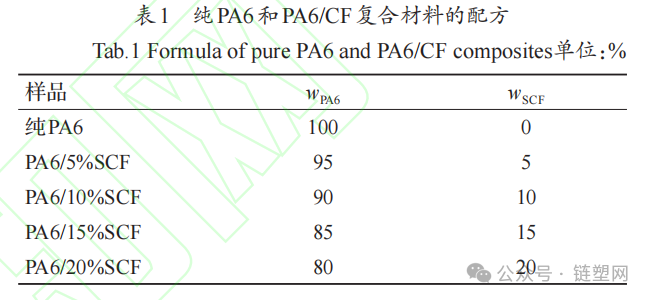
1.4 Performance Testing and Characterization
SEM test: The microstructure was observed using a scanning electron microscope with an acceleration voltage set to 15 kV.
Contact Angle Test: Measure the contact angle of PA6 melt on NCF, DCF, and SCF surfaces using optical contact angle measurement.
Single Filament Tensile Strength Test: According to ISO 11566:1996, test the tensile strength of NCF, DCF, and SCF single filaments with a tensile rate of 1mm/min.
Interlaminar shear strength test: conducted according to GB/T 30969-2014, with sample dimensions of 30mm×10mm×4mm and a shear rate of 2mm/min.
Tensile strength test: Conducted according to GB/T 1447-2005, using dumbbell-shaped samples with dimensions of 180mm × 25mm × 4mm, and a tensile rate of 2mm/min.
Bending strength test: Conducted according to GB/T 1449-2005, with sample dimensions of 80mm × 10mm × 4mm, and a bending rate of 5mm/min.
Heat resistance test: Conducted using a thermogravimetric analyzer, with approximately 5 mg sample, in a nitrogen environment, at a heating rate of 10°C/min.
2. Results and Discussion
2.1 Modification Analysis of CF
2.1.1 Micromorphology of CF
Figure 1 shows the SEM photographs of CF under different treatments. It can be seen from Figure 1 that the untreated NCF surface is relatively smooth, although some small particles can be observed, their quantity is relatively small. These small particles are the original sizing agents of CF. The DCF treated with acetone exposes the original surface of CF, which has a few shallow grooves on its surface, but overall the surface is still relatively smooth. The SCF treated with acetone and then sized with PU has a large number of small particles of sizing material, and there are also many grooves and wrinkles.
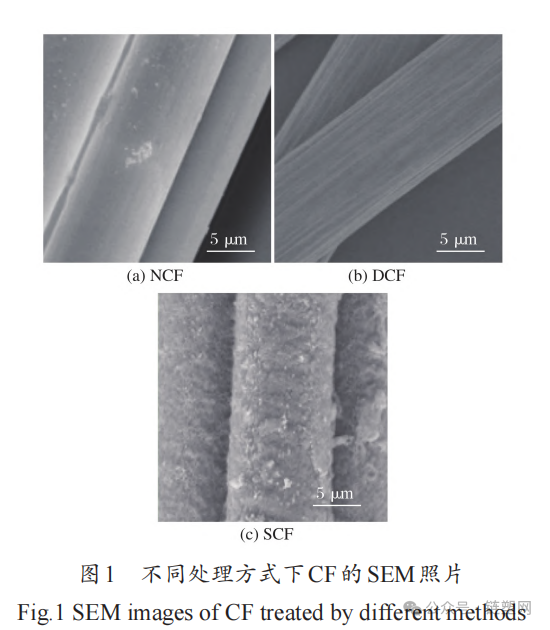
2.1.2 Contact Angle Between CF and PA6
Table 2 shows the contact angles between CF and PA6 under different treatment methods. From Table 2, it can be seen that:
The contact angle between DCF and PA6 after removing the original sizing agent with acetone is 108.6°.
The contact angle between untreated NCF and PA6 is 68.9°.
The contact angle between SCF treated with acetone and then with a water-based PU sizing agent and PA6 is 46.3°.
The contact angle between CF and PA6 without any surface coating of other modifiers is the largest. The contact angle between CF and PA6 modified by PU sizing agent is the smallest, which is reduced by 62.3° compared to DCF, indicating that CF modified by PU sizing agent has the best compatibility with PA6.
This is because the surface of CF, which has not been modified or coated with any modifiers, is inert and has low polarity, resulting in poor compatibility with PA6. The surface polarity of CF coated with sizing agents is increased, enhancing compatibility with PA6, and the contact angle becomes smaller. The original sizing agent on CF has poor compatibility with PA6, or the coating amount of the original sizing agent is limited, leading to better compatibility with PA6 after the PU sizing agent coats the CF.The contact angle between SCF and PA6 is the smallest, followed by the contact angle between NCF and PA6.。
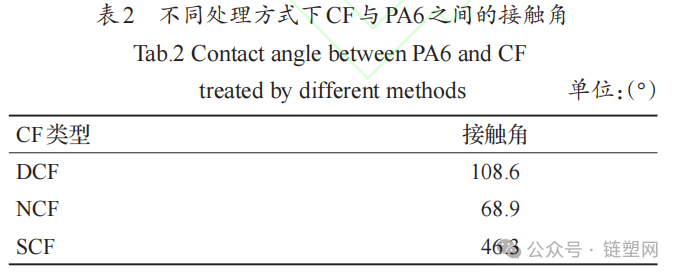
2.2 CF Monofilament Tensile Strength
Figure 2 shows the single fiber tensile strength of CF under different treatment methods. From Figure 2, it can be seen that the single fiber tensile strength of DCF is 4.9 GPa, that of NCF is 5.1 GPa, and that of SCF is 5.3 GPa, indicating that SCF has the highest single fiber tensile strength, while DCF has the lowest.
This is because the sizing agent forms a tight coating layer on the CF surface, which can fill the original grooves and defects of the CF, thus improving the integrity of the CF and enhancing its tensile strength. Moreover, the aqueous PU sizing provides a more complete and tighter coating on the CF surface (as shown in Figure 1), resulting in the highest tensile strength of the SCF. Therefore, the aqueous PU sizing agent has a better modification effect on CF.
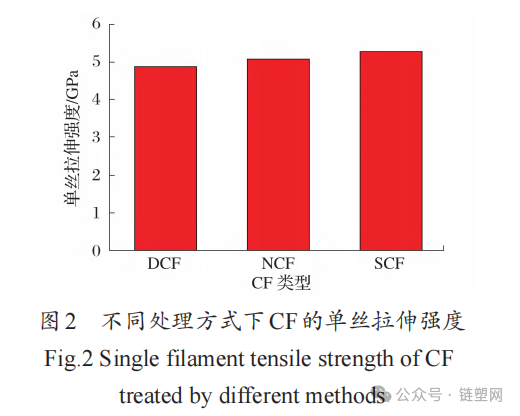
Interlaminar shear strength of 2.3 PA6/CF
Figure 3 shows the interlaminar shear strength of PA6/CF. It can be seen from Figure 3 that with the increase of SCF content, the interlaminar shear strength of PA6/CF first increases significantly and then slightly decreases, reaching a maximum when the mass fraction of SCF is 15%.
This is because the sizing agent has a large number of active groups on the surface of SCF, which allows SCF to be evenly dispersed in PA6. The molecules of the PU sizing agent on the surface of SCF intertwine, mechanically bond, or form intermolecular hydrogen bonds with PA6, enabling effective bonding between SCF and PA6. As a result, SCF uniformly bears and transmits shear loads.With a certain amount of doping, the interlaminar shear strength of PA6/CF increases with the increase in SCF doping. When the SCF content is too high.SCF may come into direct contact or agglomerate, leading to stress concentration and the formation of internal defects during processing, preventing SCF from fully exhibiting its high mechanical performance advantages.The interlayer shear strength of PA6/CF has slightly decreased.。
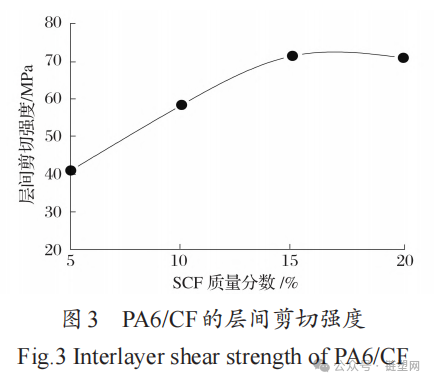
Mechanical Properties of 2.4 PA6/CF
Figure 4 shows the tensile strength and flexural strength of pure PA6 and PA6/CF. From Figure 4, it can be seen that with the increase of SCF content, the tensile and flexural strengths of PA6/CF initially increase significantly and then increase slowly. When the mass fraction of SCF is 15%, the tensile strength and flexural strength reach 218.2 MPa and 300.3 MPa, respectively, which are 316.4% and 198.8% higher compared to pure PA6. Increasing the SCF mass fraction to 20% results in tensile and flexural strengths of 219.0 MPa and 301.6 MPa, respectively, only 0.37% and 0.43% higher than PA6/15% CF.
This is mainly because the tensile strength and flexural strength of CF are much higher than those of PA6. Adding SCF to PA6 can transmit and bear destructive loads, especially after the CF surface is modified with a sizing agent, which improves the interfacial bonding between SCF and PA6.SCF significantly improves the tensile strength and flexural strength of PA6/CF.However,When the dosage of SCF is excessiveAt this point, the contribution of excessive SCF to performance has basically reached its limit. Excessive SCF can easily lead to a deterioration in dispersion uniformity, causing agglomeration, resulting in processing difficulties, internal defects, and stress concentration.The effect of SCF on improving the tensile strength and bending strength of PA6/DCF is limited, so the increase is minimal.。
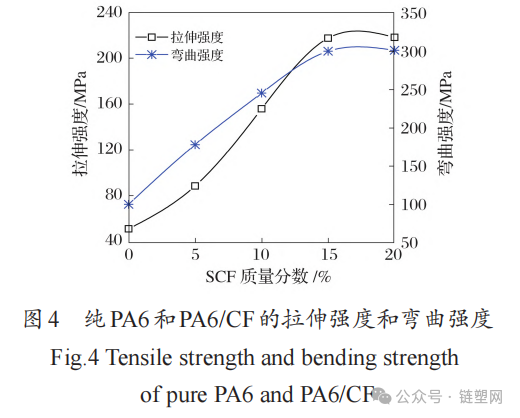
Figure 5 shows the SEM images of the fracture surface of the tensile strength samples of PA6/CF. It can be seen from Figure 5 that...
When the mass fraction of SCF is 5%~15%SCF is uniformly dispersed in the PA6 matrix, with PA6 resin wrapped around the fractured SCF, and the amount of SCF increases.
When the mass fraction of SCF increases to20% Some SCF were pulled out, leaving holes, and there was very little PA6 resin wrapped around some of the SCF.
Because excessive SCF leads to agglomeration, some SCF cannot be completely encapsulated by the PA6 matrix and tends to cause defects in the composite material system, making it easy for SCF to be pulled out.This further verifies the reason why the tensile strength and flexural strength first increase significantly and then grow slowly.
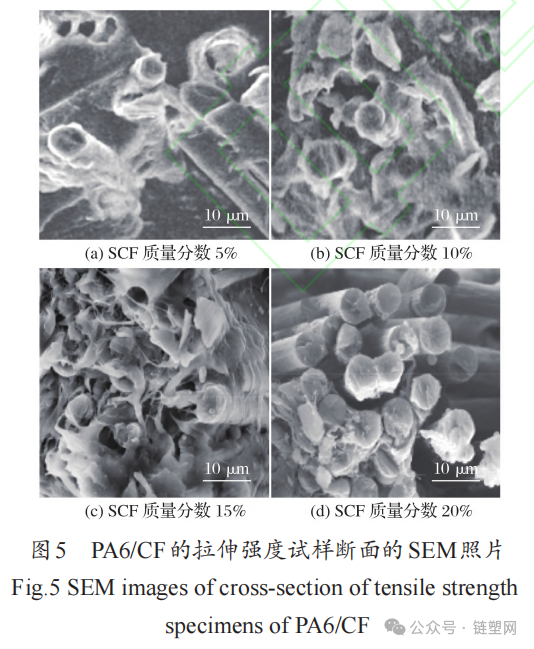
2.5 Heat Resistance of PA6/CF
Figure 6 shows the TG curves of pure PA6 and PA6/CF. From Figure 6, it can be seen that without adding SCF, the initial decomposition temperature (t₀) of pure PA6 is 346°C, and the temperature corresponding to the maximum decomposition rate (t) is...maxThe temperature is 451℃, and the final mass retention rate (w).losThe thermal decomposition of PA6 primarily involves the initial decomposition into aliphatic hydrocarbons and oligomers, ultimately leading to the formation of H₂O and CO₂. As the SCF content continues to increase, the thermal decomposition curve of PA6/CF shifts upward, with t₀, t.max: and : Translate the above content into English, directly output the translation result without any explanation.losThe increasing trend indicates that the thermal stability of PA6/CF has improved.
When the mass fraction of SCF is 5%, the t₀ of PA6/CF is 357℃.maxFor 465℃, wlos6.9%
When the mass fraction of SCF is 10%, the t₀ of PA6/CF is 369℃.maxAt 479℃, wlos 12.0%.
When the mass fraction of SCF is 15%, the t₀ of PA6/CF is 382°C, tmaxAt 493℃, wlosThe figure is 16.8%.
When the mass fraction of SCF is 20%, the t₀ of PA6/CF is 383℃, tmaxFor 495℃, wlos21.7%.
It can be seen that when the mass fraction of SCF is 5%~15%, the thermal stability of PA6/CF improves rapidly. Compared with pure PA6, t₀ increases by 36°C and t_max increases by 42°C. When the mass fraction of SCF is 20%, the rate of improvement in thermal stability of PA6/CF slows down, with t₀ and t_max increasing by only 1°C and 2°C respectively compared to when the mass fraction of SCF is 15%. Additionally, the increase in w_los of PA6/CF is basically close to the increase in SCF content.
The reason for the above results is that the heat resistance of CF contained in SCF is much higher than that of PA6. The addition of SCF improves the thermal stability of PA6/CF, thus increasing t₀ and t_max. When the mass fraction of SCF reaches 15%, the effect of SCF on improving the thermal stability of PA6/CF basically reaches its maximum. Therefore, further increasing the mass fraction of SCF to 20% does not significantly change the thermal stability of PA6/CF. Although the addition of SCF improves the thermal stability of PA6/CF, the PA6 molecules continuously decompose at high temperatures. SCF mainly inhibits the decomposition rate of PA6 and has little effect on the decomposition residue of PA6. In addition, the PU sizing agent on the surface of SCF also decomposes at high temperatures, resulting in an increase in the w_los value of PA6/CF, which is close to the variation of SCF content.
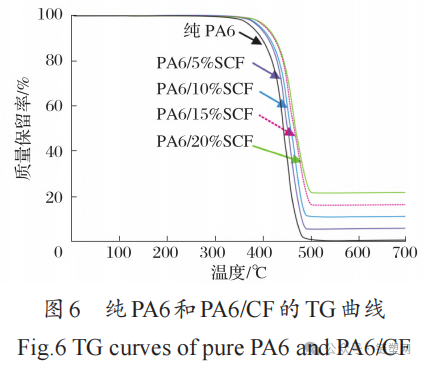
Conclusion
The surface of DCF is relatively smooth; the surface of NCF has the original sizing agent and some small particles, but it is also relatively smooth; the surface of SCF is coated with a sizing agent, contains a large number of small particles, and has formed many grooves and wrinkles. The contact angle between DCF and PA6 is 108.6°, the contact angle between NCF and PA6 is 68.9°, and the contact angle between SCF and PA6 is 46.3°. This indicates that the compatibility between DCF, which is not coated with other modifiers, and PA6 is the worst, while the compatibility between SCF, modified with PU sizing agent, and PA6 is the best. DCF has the lowest tensile strength for single filaments, while SCF has the highest tensile strength for single filaments.
With the increase in SCF content, the interlaminar shear strength of PA6/CF initially increases significantly and then slightly decreases. The interlaminar shear strength reaches its maximum when the mass fraction of SCF is 15%.
As the SCF content increases, the tensile strength and flexural strength of PA6/CF both initially increase significantly and then increase slowly. When the mass fraction of SCF is 15%, the tensile strength and flexural strength are improved by 316.4% and 198.8% compared to pure PA6.
As the SCF content increases, the thermal stability of PA6/CF gradually improves. When the mass fraction of SCF is 5% to 15%, the thermal stability of PA6/CF increases rapidly, with t₀ increasing by 36℃ and t_max increasing by 42℃ compared to pure PA6. When the mass fraction of SCF reaches 20%, the rate of improvement in thermal stability slows down. Considering both cost and performance, the optimal mass fraction of SCF is 15%.
【Copyright and Disclaimer】The above information is collected and organized by PlastMatch. The copyright belongs to the original author. This article is reprinted for the purpose of providing more information, and it does not imply that PlastMatch endorses the views expressed in the article or guarantees its accuracy. If there are any errors in the source attribution or if your legitimate rights have been infringed, please contact us, and we will promptly correct or remove the content. If other media, websites, or individuals use the aforementioned content, they must clearly indicate the original source and origin of the work and assume legal responsibility on their own.
Most Popular
-

List Released! Mexico Announces 50% Tariff On 1,371 China Product Categories
-

Nissan Cuts Production of New Leaf EV in Half Due to Battery Shortage
-

New Breakthrough in Domestic Adiponitrile! Observing the Rise of China's Nylon Industry Chain from Tianchen Qixiang's Production
-

Dow, Wanhua, Huntsman Intensively Raise Prices! Who Controls the Global MDI Prices?
-

Mexico officially imposes tariffs on 1,400 chinese products, with rates up to 50%






